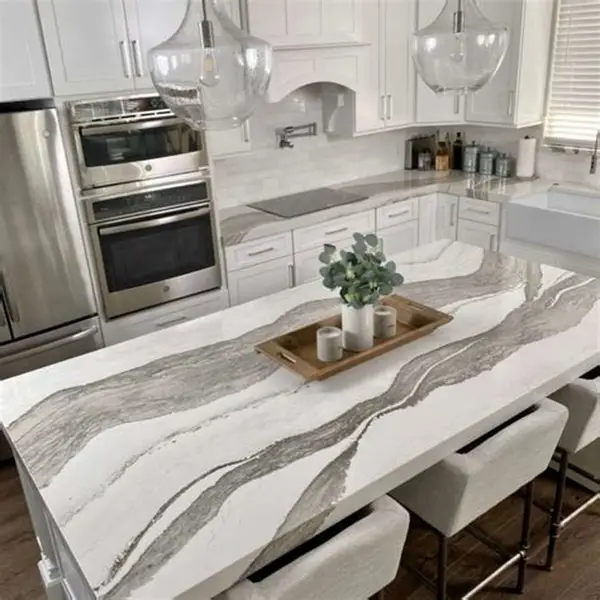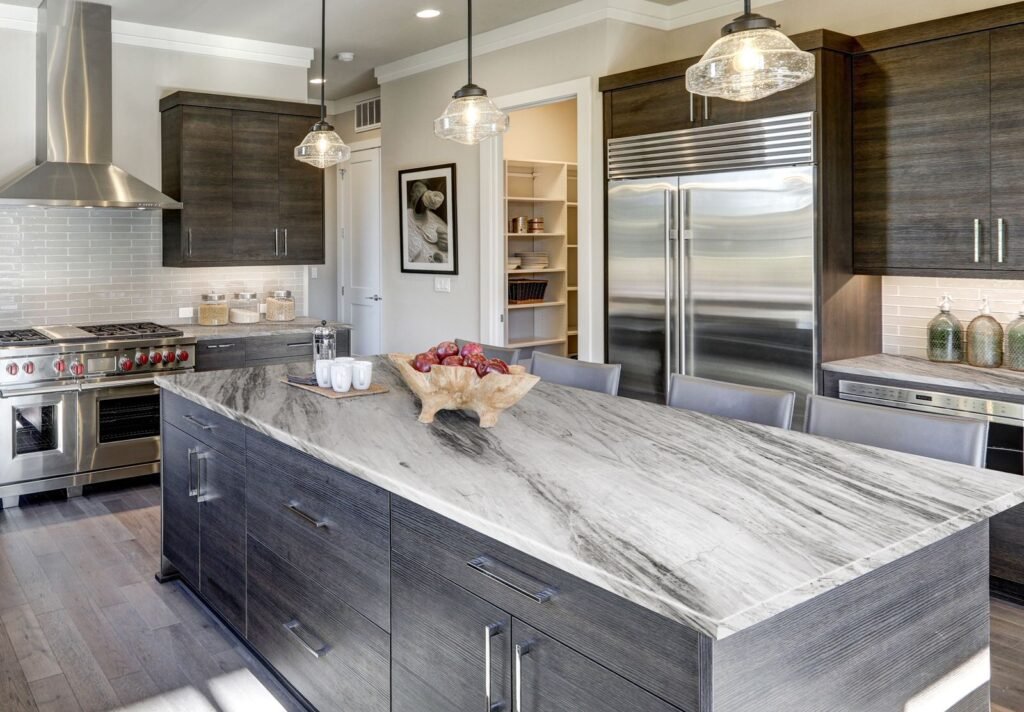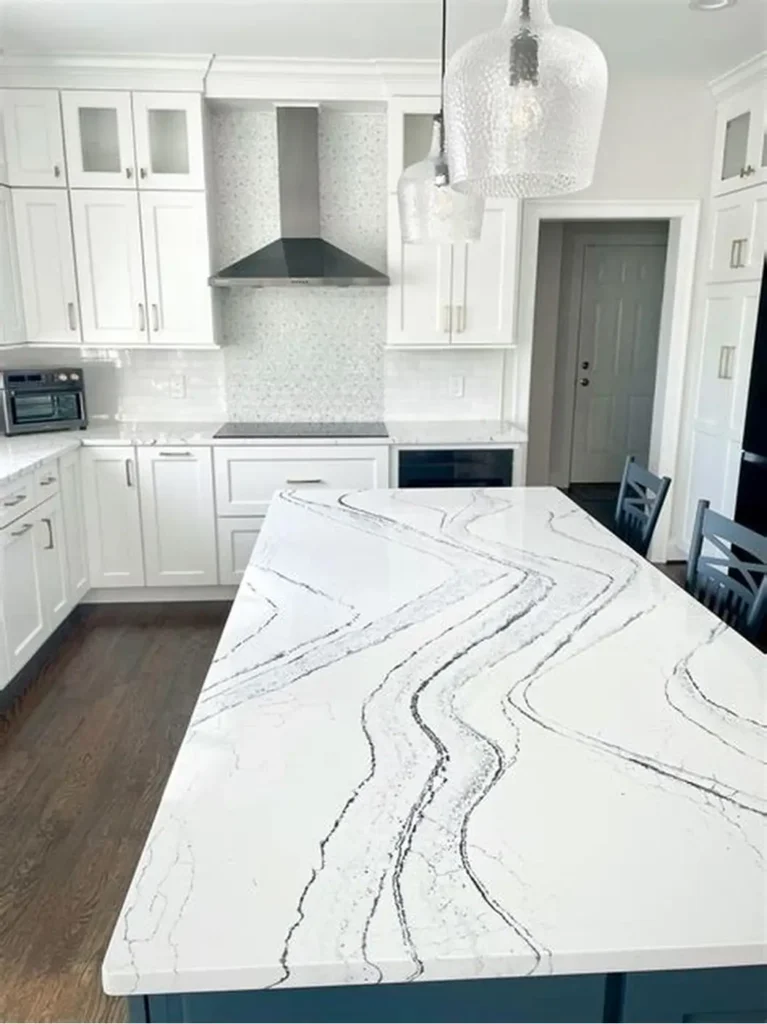Rust marks the orange ring from a shaving can, the halo from a cast-iron pan, or tiny brown freckles near a faucet can spoil the look of even the most beautiful granite countertops. The good news: you can remove rust thoroughly without scratching the surface, stripping the sealer, or changing the polish, as long as you use stone-safe methods. This comprehensive, semantic-SEO guide covers identification, chemistry, step-by-step poultice removal, prevention, and when to reseal—plus smart tips on choosing products and caring for granite stone day to day.

Why It Happens
Rust is iron oxide—it forms when iron meets water and oxygen. On a countertop, that usually comes from:
- Wet metal objects sitting on the surface (razor cans, cast-iron cookware, steel caddies).
- Iron-rich water around sinks or faucets that isn’t wiped dry.
- Hidden sources like uncoated metal feet on appliances or accessories.
- In rarer cases, iron-bearing inclusions within the slab near the surface.
Because granite geology and composition includes hard minerals such as quartz, feldspar, and mica, the stone is durable—but it has microscopic pores. Rust pigments can lodge in those pores, which is why regular cleaning doesn’t budge them. You need the right chemistry plus absorption.

Identify the Stain: Is It Really Rust?
Before treatment, confirm it’s rust and not food, oil, or soap scum.
- Color & pattern: Rust is yellow-orange to reddish brown, often a ring (under a can) or specks near water.
- Quick peroxide check: A drop of 3–6% hydrogen peroxide lightens organic stains (coffee/tea). If it doesn’t change, the stain may be rust or oil.
- Texture: Rust is a stain (flat). Rough, dull patches suggest etching—common on marble, rare on granite.
- Oil test: Oil stains darken the stone and spread softly at the edges; rust edges are usually sharper or ring-shaped.
For oil-specific guidance, bookmark:
• How to get stains out of granite
• How to remove a stain from granite
• How to get oil out of granite
• Alternate method: oil removal
The Safest & Most Effective Method: A Stone-Safe Rust Poultice
A poultice keeps a rust-dissolving agent in prolonged contact with the stain while an absorbent pulls the dissolved iron up and out. It’s the professional standard on natural stone.
What You’ll Need (H3)
- Granite-safe rust remover (label must say safe for natural stone).
- Absorbent powder: diatomaceous earth, kaolin clay, or talc.
- pH-neutral stone cleaner (for prep and final clean).
- Plastic wrap and painter’s tape (slow evaporation).
- Plastic scraper, microfiber cloths, nitrile gloves, eye protection.
- Optional neutralizer: baking-soda solution (1 Tbsp per quart/1 L water).
Avoid: generic rust sprays not rated for stone, vinegar/citrus acids, bathroom acids, oxalic powders with abrasives, steel wool, and chlorine bleach. These can etch, scratch, or set stains.
Step-by-Step Removal (H3)
- Pre-clean & dry
Spray a pH-neutral cleaner made for clean granite countertops. Rinse and dry thoroughly. Dry stone absorbs poultice action more effectively. - Mix the poultice
In a non-metal bowl, combine the granite-safe rust remover with your absorbent to a peanut-butter thickness. You want it to cling and dry evenly. - Apply generously
Trowel the paste ¼–½ inch (6–12 mm) thick over the stain, extending ½–1 inch (1–2.5 cm) beyond the edge. Stains can migrate microscopically. - Cover & dwell
Cover with plastic wrap and tape the edges to slow evaporation. Let it sit 12–24 hours so chemistry can reach into the pores. - Uncover & dry completely
Remove the plastic. Allow the poultice to dry hard (another 12–24 hours). Drying is when dissolved rust wicks into the absorbent. - Lift, neutralize, rinse
Gently lift with a plastic scraper, wipe residue, then wipe with baking-soda solution to neutralize any leftover acidity. Rinse with clean water and dry. - Repeat as needed
Deep or older stains may require 2–3 cycles. Each round should noticeably lighten the discoloration.
Alternative Spot Treatments (Use Carefully)
For tiny freckles, some pros use gelled oxalic acid products labeled for natural stone:
- Patch test in an inconspicuous spot.
- Limit contact time (10–30 minutes).
- Always neutralize and rinse.
- If the shine dulls or the color shifts, stop and return to a poultice.
After Care: Do You Need to Reseal?
Once the area is fully dry, do the water-drop test:
- Put a teaspoon of water on the cleaned area.
- If the stone darkens within 3–5 minutes, the sealer is weak—re-seal.
- If there’s no darkening after 10–15 minutes, the sealer is still working.
How to Spot-Seal Seamlessly (H3)
- Clean and dry the area.
- Apply a penetrating granite sealer per label directions (thin, even coat).
- Buff off all residue within the dwell time to prevent hazing.
- After curing, re-test with water; add a second coat if needed.
Prevention: Keep Rust from Coming Back
- Lift metal: Place cast-iron, steel canisters, and razor cans on silicone mats or plastic trays.
- Wipe around sinks: Especially if you have hard or iron-rich water.
- Choose corrosion-resistant accessories: Stainless or powder-coated finishes with rubber or silicone feet.
- Maintain sealing: Perform the water test every 6–12 months in high-use zones.
- Daily cleaner: Stick to pH-neutral formulas; skip vinegar or bleach.
Troubleshooting the Tough Cases
- Shadow remains after two poultices: Try a third cycle with a fresh batch; increase dwell to the high end of the label’s range.
- Rust returns in the same spot: Inspect for a hidden iron source (screws, metal feet). Replace or isolate with a barrier pad.
- Discoloration spreads: You may be dealing with oil + rust (a pan with seasoning oil). Run an oil poultice next, then repeat rust treatment. See:
• How to remove a stain from granite
• How to get oil out of granite
• Alternate oil method
Care & Style: Keep Your Granite Looking New
Characteristics of Granite in Everyday Use (H3)
- Durability: Highly scratch-resistant and heat tolerant.
- Porosity: Varies by color/finish; polished often resists absorption better than honed/leathered.
- Maintenance: Occasional sealing granite preserves stain resistance; routine cleaning keeps the surface bright.
Design Tips That Reduce Stain Risk (H3)
- Granite backsplash designs and a subtle front drip edge help keep standing water away from metal objects.
- Coordinate pairing granite with cabinet colors to minimize visual clutter (fewer countertop caddies = fewer rust risks).
- Whether you love a white granite countertop or black granite countertops, use trays under frequently wet items.
Natural Stone Countertop Comparison (H3)
- Granite vs quartz countertops: Quartz is low-maintenance; granite handles heat better and offers natural variation.
- Granite vs marble: pros and cons: Granite is harder and less prone to etching.
- Granite vs soapstone durability: Soapstone is soft but easy to refinish; granite is harder and resists scratching.
- Granite better than concrete countertops: For many homes, granite’s stain/heat profile and lower maintenance win.
Repair & Refresh: When Stains Aren’t the Only Issue
- Repairing chips in granite: Use color-matched epoxy; many pros can make fills invisible.
- Polishing granite surfaces: After stain removal, clean, dry, and apply a non-waxy stone polish (optional) to boost luster.
- Removing stains from granite beyond rust: Oil, wine, ink, and hard-water deposits each have targeted poultices or cleaners; address the cause and reseal as needed.
Buying Smarter: Cost, Sourcing & Aardwolf Solutions
- Granite countertop cost depends on color rarity, thickness, finish, and edge profile.
- Where to buy granite countertops: Visit showrooms and explore wholesale granite suppliers for value selections and remnants.
- Elevate your project with the Aardwolf granite countertop collection, Aardwolf premium granite slabs, and Aardwolf granite installation services—from selection to safe handling to install.
- Consult an Aardwolf granite pricing guide when budgeting and shortlist the best Aardwolf granite colors for your cabinets and flooring.
Quick Reference: Stone-Safe Rust Removal Checklist
- Confirm rust (orange/brown ring or specks; peroxide test unchanged).
- Pre-clean & dry with a pH-neutral stone cleaner.
- Mix poultice (granite-safe rust remover + absorbent).
- Apply ¼–½ in thick, extend past stain.
- Cover 12–24 h (plastic wrap).
- Uncover & dry 12–24 h to harden.
- Lift, neutralize, rinse, dry.
- Repeat up to 2–3 cycles if needed.
- Water-drop test; re-seal if darkening occurs in 3–5 minutes.
- Prevent with trays/mats and quick wipe-downs near sinks.
FAQs
Can I use vinegar or lemon on rust?
No. Acids can etch natural stone and weaken sealers. Use a granite-safe rust remover instead.
Will bleach remove rust from granite?
Bleach can discolor or set stains—skip it. Choose rust products labeled safe for natural stone.
Are Magic Erasers okay?
They may reduce surface transfer but don’t extract rust pigments from pores. The poultice method is the reliable fix.
How often should I reseal after stain removal?
There’s no fixed schedule. Use the water-drop test in high-use areas every 6–12 months and seal as needed.

